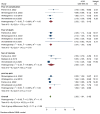Prevalence of Preoperative Anxiety and Associated Factors Among Surgical Patients: Systematic Review and Meta-Analysis in Ethiopia
- PMID: 39906885
- PMCID: PMC11792019
- DOI: 10.1177/11786329251316748
Prevalence of Preoperative Anxiety and Associated Factors Among Surgical Patients: Systematic Review and Meta-Analysis in Ethiopia
Abstract
Background: Preoperative anxiety is commonly characterized as a feeling of tension, apprehension, nervousness, distressing fear, and emotional discomfort preceding surgery. Different studies across the countries indicated an inconsistent prevalence of preoperative anxiety and its associated factors. Therefore, this study aimed to determine the pooled prevalence of preoperative anxiety and associated factors among surgical patients in Ethiopia.
Methods: In this study, all observational study designs conducted in Ethiopia were included while studies that did not report our main outcome of interest or did not meet the quality criteria by Joanna Briggs Institute (JBI) critical appraisal techniques were excluded. Electronic databases (PubMed, SCOPUS, Web of Science Core Collection, CAB Abstract, EMBASE, and CINHAL (EBSCO)), Google Scholar, and lists of references were used to search works of literature in Ethiopia. STATA version 17 was used for analysis, and the odds ratios of the outcome variable were determined using the random-effects model. Computing values assessed heterogeneity among the studies for I 2 and P-values. Also, sensitivity analysis and funnel plot were done to assess the stability of pooled values to outliers and publication bias respectively.
Results: A total of 10 studies were included with a total of 3054 participants. The pooled prevalence of preoperative anxiety among surgical patients in Ethiopia was 60% (95% CI: 55-66, P < .001, I 2 = 90.00%). The overall prevalence among non-obstetric patients was 59% (95% CI: 53-66) while among obstetric 66% (95% CI: 62-69). Fear of complication (AOR = 2.32, 95% CI: 1.23, 3.41, P = .62, I 2 = 0.00%), postoperative pain (AOR = 1.92, 95% CI: 1.29, 2.56, P = .37, I 2 = 0.00%), and fear of death (AOR = 2.27, 95% CI: 1.53, 3.00, P = .70, I 2 = 0.00%) were significantly associated with preoperative anxiety.
Conclusion: This study revealed a high pooled prevalence of preoperative anxiety among surgical patients in Ethiopia. The findings showed that fear of complication, postoperative pain, and fear of death were significantly associated with preoperative anxiety. This implies that a multidisciplinary approach involving various healthcare professionals is essential to optimize patient care and outcomes by addressing postoperative pain through pain management, counselling on fear of death, and complications to reduce the level of preoperative anxiety.
Keywords: Ethiopia; Preoperative anxiety; meta-analysis; pooled prevalence; surgical patients; systematic review.
© The Author(s) 2025.
Conflict of interest statement
The author(s) declared no potential conflicts of interest to the research, authorship, and/or publication of this article.
Figures









Similar articles
-
Prevalence and associated factors of sexual violence experienced by housemaids in Ethiopia: a systematic review and meta-analysis.Reprod Health. 2022 Jul 19;19(1):162. doi: 10.1186/s12978-022-01470-2. Reprod Health. 2022. PMID: 35854381 Free PMC article.
-
Burden of malnutrition among cancer patients in Ethiopia: a systematic review and meta-analysis.BMC Public Health. 2025 Apr 17;25(1):1440. doi: 10.1186/s12889-025-22606-6. BMC Public Health. 2025. PMID: 40247221 Free PMC article.
-
Prevalence and Patterns of Neonatal Birth Trauma in Ethiopia: Systematic Review and Meta-Analysis.Glob Pediatr Health. 2023 Aug 16;10:2333794X231191982. doi: 10.1177/2333794X231191982. eCollection 2023. Glob Pediatr Health. 2023. PMID: 37602141 Free PMC article.
-
Childbirth at home and associated factors in Ethiopia: a systematic review and meta-analysis.Arch Public Health. 2021 Apr 13;79(1):48. doi: 10.1186/s13690-021-00569-5. Arch Public Health. 2021. PMID: 33849638 Free PMC article.
-
Knowledge, attitude, practice and associated factors of oxygen therapy among health professionals in Ethiopia: A systematic review and meta-analysis.PLoS One. 2024 Sep 6;19(9):e0309823. doi: 10.1371/journal.pone.0309823. eCollection 2024. PLoS One. 2024. PMID: 39240945 Free PMC article.
References
-
- Sadock BJ, Sadock VA, Ruiz P. Comprehensive Textbook of Psychiatry. Vol. 1. Lippincott Williams & Wilkins; 2000.
-
- VandenBos GR. APA Dictionary of Psychology. American Psychological Association; 2007.
-
- Aust H, Eberhart L, Sturm T, et al.. A cross-sectional study on preoperative anxiety in adults. J Psychosom Res. 2018;111:133-139. - PubMed
-
- Sigdel DS. Perioperative anxiety: a short review. Glob Anesth Perioper Med. 2015;1:107-108.
-
- Friedrich S, Reis S, Meybohm P, Kranke P. Preoperative anxiety. Curr Opin Anaesthesiol. 2022;35:674-678. - PubMed
Publication types
LinkOut - more resources
Full Text Sources

